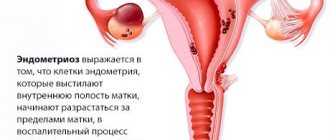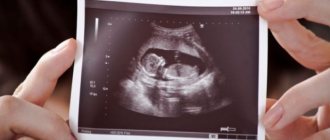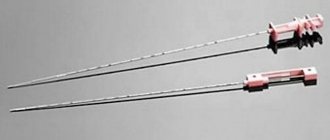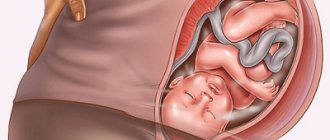Endometriosis is considered perhaps the most common disease of the female genital area, next to it are thrush and vaginosis: seven out of a hundred women aged 14 to 50 years have one form or another of the disease. In addition, it is found in approximately 35% of patients who turned to the doctor because of the inability to get pregnant; every fifth of this number subsequently has to resort to in vitro fertilization.
IVF for endometriosis is a very effective way to combat infertility in women who have been diagnosed with this pathology. For this reason, modern reproductology pays special attention to the issue of IVF and the study of this disease; great efforts are made to increase the effectiveness of the technique.
IVF for endometriosis
Endometriosis is one of the most pressing problems of modern gynecology and reproductive medicine. In the structure of diseases of the female reproductive system, it ranks third, second only to infections and fibroids.
Endometriosis is the main cause of chronic pelvic pain and one of the basic factors in the development of infertility in women. It is this chronic disease that explains the difficulties with natural conception in 20–48% of patients, and the conservative therapy prescribed does not always give the expected result and leads to the desired pregnancy. Therefore, IVF is now increasingly being included in the treatment regimen for endometriosis in women of reproductive age.
Immured eggs
How does modern medicine combat infertility caused by endometriosis, the second most common disease among women in Russia? The chief doctor of the Moscow Ma-Ma Reproduction Clinic, Victoria Viktorovna ZAEVA, tells the story.
Almost half of the women who come to our clinic with infertility problems suffer from endometriosis. The reasons why this immune-hormonal disease prevents pregnancy are manifold. According to statistics, in approximately 90 percent of cases, patients have an adhesive process inside the pelvis. Hence - literally distorted fallopian tubes, surrounded by a “cocoon” of adhesions, completely isolated ovaries. The eggs walled up in such a “cave” remain inside, never entering the fallopian tube. The most severe form of the disease also occurs - direct damage to ovarian tissue by endometriosis cysts, when the uterus, tumor and adjacent peritoneum fusion occurs. In addition, such cysts can degenerate into malignant ones, so in such a case, the treatment plan necessarily includes surgery to remove them. Another, quite common option is the absence of pregnancy with preserved patency of the fallopian tubes. The reason here is that the adhesive cocoon formed around them prevents their normal movements. After all, getting an egg into the tube is an active process. To do this, the tube must approach the place of “hatching” and, due to soft wave-like contractions, capture and “suck in” the egg. When the fallopian tubes, bound by adhesions, can neither move nor move, such a meeting, naturally, does not occur. And the sperm, waiting in the tube for its “betrothed,” remains unclaimed. Hormonal obstacles to conception and pregnancy also occur with endometriosis. Weak ovulation due to a lack of the hormone that “triggers” it, an excess of the female sex hormone estrogen, low activity of the corpus luteum in the second phase of the menstrual cycle. These numerous hormonal errors in the functioning of the body are reflected in the uterine cavity - they do not allow it to properly prepare for the attachment of the embryo. Moreover, it happens that with endometriosis, special substances appear in the abdominal cavity, as if specifically designed to make conception and pregnancy difficult. They interfere with the movement of sperm and the formation of the embryo, literally eating the embryo. It is clear that with such a wide range of disorders, there cannot be a single treatment regimen suitable for all patients. After all, a lot also depends on the severity of the disease, the location of the disease, and, of course, the age of the woman. When the patient is young, in mild cases of endometriosis she is prescribed new effective medications that block the onset of menstruation. During this forced hormonal “rest,” the foci of endometriosis in the body decrease. So, after stopping the medications and restoring the normal female cycle, spontaneous pregnancy becomes possible. In more severe cases, it is necessary to combine surgical removal of pathological foci and adhesions with subsequent drug treatment. Most often, deposited drugs are used, for example, Zoladex or Decapeptyl. Both of these treatment options, regardless of the severity of endometriosis, can only help those women who do not have tubal pathology. After all these efforts, pregnancy occurs in about a third of them. If a patient with patent tubes does not become pregnant after laparoscopic surgical treatment for a year, she should resort to the method of in vitro fertilization - IVF. In cases where it is determined during laparoscopy that the tubes are impassable, IVF should be addressed immediately, without wasting precious months and years. Often, in order to normalize disrupted hormonal levels and grow a sufficient number of strong, full-fledged eggs in the ovaries, special drug therapy has to be carried out over not one, but two or three menstrual cycles. During this time, in accordance with clear commands from the stimulated ovaries, the quality of the endometrium in the uterus also manages to significantly improve. Then, the viable embryos obtained after fertilization of the eggs develop for some time in conditions that fully correspond to natural ones. And only when they reach the so-called blastocyte stage, the grown and strengthened embryos are transferred to the mother’s body. This treatment route brings desired pregnancy to married couples. And finally, when fertilization does not occur with the “classical” scheme due to immune disorders caused by unknown causes, the ICSI method is currently successfully used. It consists in the fact that, with the help of special devices, the sperm is injected directly into the egg.
What is endometriosis
Endometriosis is a disease characterized by the appearance in a woman of ectopic foci of proliferation of endometrial tissue. Normally, it forms the mucous membrane of the uterus (endometrium), and its cells are not able to overcome the basement membrane and cannot be found in the thickness of other tissues. And with endometriosis, they form abnormally located foci and acquire the ability to germinate, spread through the bloodstream and progressively develop.
The most common diagnosis is genital or pelvic endometriosis. This may affect:
- myometrium (muscular layer of the uterine body), in this case they speak of adenomyosis;
- Cervix;
- tissues of the vagina and vulva;
- retrocervical tissue (in the cervical area);
- the fallopian tubes;
- ovaries;
- peritoneum adjacent to the internal genital organs.
Endometrioid tissue remains sensitive to fluctuations in estrogen levels in a woman’s body and is even capable of activating the production of this hormone. Therefore, the foci it forms change cyclically, just like the normal uterine endometrium. They undergo alternate growth and rejection of the functional layer, which most often roughly correlates with menstruation. If the rejected tissue and blood have no outlet, then over time an endometrioid cyst with thick black-chocolate contents forms. And superficially located lesions can lead to the development of recurrent bleeding.
Causes of endometriosis
Endometriosis is the growth of the lining of the uterus (endometrium) onto other organs. Endometriosis can spread only to the reproductive organs or, in rare cases, to the abdominal cavity. This disease is extremely common and, according to statistics, approximately every tenth young woman is affected by it. The disease can lead to extremely unpleasant and dangerous complications: problems with conception, malignant degeneration of cells, etc. Possible reasons why the disease can lead to infertility:
- An adhesive process in the pelvis, as a result of which the patency of the tubes is disrupted. Adhesions can appear inside the tube, preventing the sperm and egg from meeting. Also, adhesions can bend the tube, which also complicates the process of conception. The most dangerous consequence in this case is an ectopic pregnancy.
- Release of toxic substances from the degenerated uterine lining.
- Decreased egg quality.
- Uterine fibroids, scar tissue on the lining that makes it difficult for a fertilized egg to attach. In addition, this reason can lead to problems with pregnancy due to the low location of the placenta.
Why does endometriosis so often lead to infertility?
Infertility occurs in a significant proportion of women with genital endometriosis. This is explained by several points:
- An inflammatory reaction is maintained around endometriotic growths, which contributes to the formation of adhesions and atrophy. As a result, the normal endometrium becomes thinner, and adhesions form in the tubes, abdominal cavity and sometimes in the lumen of the uterus. This prevents the advancement of germ cells and normal implantation of the fertilized egg, and the woman develops tubal, peritoneal and uterine infertility.
- Miscarriage, embryo rejection in the early stages of pregnancy. This is due to insufficient thickness of the endometrium, increased tone of the uterus affected by endometriosis and hormonal imbalance.
- Maintaining relative or even absolute hyperestrogenism, which can lead to an imbalance in the functioning of the ovaries-pituitary-hypothalamus chain and to anovulation.
- Production of antibodies to endometrial cells. More precisely, they are initially directed against endometrioid cysts, but also react to the normal mucous membrane of the uterus and prevent implantation of the fertilized egg. Immunoresistance of the endometrium towards the embryo is also formed.
To overcome infertility, it is not enough to remove or suppress large endometrioid foci in the uterus; a complex effect is required.
Why does endometriosis cause infertility?
Endometriosis significantly reduces the chances of conception and successful pregnancy, which is associated with accompanying complications. These include:
1. Changes in the pelvic organs
In 80% of all cases of the disease, endometriotic lesions form an adhesive process in the pelvis, disrupting the patency of the fallopian tubes or forming dense tissue adhesions. This causes disruption of the ovulation process and egg movement.
2. Disruption of endocrine processes
Foci of endometriosis synthesize biologically active substances (prostaglandins, interleukins, etc.), which disrupt homeostasis in the abdominal cavity and negatively affect the maturation of the egg. In addition, the balance of luteinizing hormone and estrogen is disrupted, which causes disturbances or absence of ovulation.
3. Immune process disorder
Antisperm bodies are often found in the body of women suffering from endometriosis. In addition, autoimmune processes develop on the surface of the uterine mucosa, which interfere with the normal process of implantation of a fertilized egg, thereby causing the development of infertility.
These complications are not amenable to hormonal or surgical treatment in all cases: within a year after completion of therapy, even in the absence of pronounced adhesions and damage to the fallopian tubes, pregnancy occurs in approximately 35% of cases. Therefore, in vitro fertilization is considered one of the most effective methods of treating infertility with endometriosis.
How to treat it
Treatment for endometriosis may include several components:
- The use of hormonal drugs to temporarily equalize the patient’s hormonal levels. These can be COCs (combined oral contraceptives), the Mirena spiral, AGnH (gonadotropin-releasing hormone agonists), androgen derivatives. Hormonal therapy usually lasts 2–6 months, and its effectiveness is assessed no earlier than 3 months of treatment.
- Surgical interventions. Currently, preference is given to organ-preserving and minimally invasive operations. During hysteroscopy, an endometrial biopsy is performed, if necessary, polyps, large lesions, endometrioid nodes and cysts are removed, and adhesions are dissected. In this case, manipulations are carried out as gently as possible to prevent subsequent scarring.
- Physiotherapy.
- Symptomatic therapy, usually to alleviate pain. Most often, antispasmodics and NSAIDs are used for this purpose.
- Assisted reproductive technologies to overcome persistent infertility. The most popular technique for genital endometriosis is IVF.
The treatment regimen is selected by the doctor and depends on the patient’s age, the prevalence and severity of endometriosis, the presence of life-threatening complications for the woman and the need to restore fertility.
The place of IVF in overcoming the consequences of endometriosis
IVF for endometriosis is not performed on all patients with infertility. Indications for its use include:
- The patient's age is over 38 years, even if she is diagnosed with stage 1–2 endometriosis with a potentially good response to conservative therapy. Women in this age group need to enter the IVF protocol as soon as possible, because their ovarian reserve is progressively depleted. And when using a traditional therapeutic approach, there is a risk of not receiving the egg necessary for conception after completion of treatment.
- Detection of grade 4 adenomyosis, peritoneal and retrocervical endometriosis. With such severe forms of the disease, it is difficult to expect high effectiveness from organ-saving surgical and conservative treatment. The chance of restoring the ability to conceive independently in such women is small, and IVF for them becomes the most promising way to achieve pregnancy.
- Ineffectiveness of complex active treatment of endometriosis carried out for 2 years. The persistence of infertility in a woman, despite the improvement in the condition of the uterus and other affected organs, is the basis for the use of IVF.
Features of IVF for endometriosis
For endometriosis, the IVF protocol generally does not differ from the standard one, and to increase the likelihood of pregnancy, a combination of IVF + ICSI is often used. Only the preparatory stage is carried out with special care. After all, the readiness of the woman’s body for successful implantation of the fertilized egg and subsequent pregnancy largely depends on its results.
During the period of preparation for IVF, individually selected hormonal therapy is necessarily prescribed. It is necessary to achieve a stable, controlled decrease in estrogen levels in a woman’s body. This will lead to a partial reduction of endometriosis foci and stabilization of the patient’s condition.
If necessary, minimally invasive surgical treatment is also performed before IVF, usually before the start of basic hormonal therapy. At the same time, adhesions, treatment-resistant endometrioid nodes and cysts, and polyps are carefully eliminated.
Further stages of IVF (stimulation of hyperovulation, collection of eggs ready for ovulation, fertilization, cultivation, transfer of selected embryos) for endometriosis do not have any significant features.
Treatment of endometriosis at ICLINIC: modern approach and good results
Treating infertility with IVF for endometriosis is a task that requires a doctor’s professional instincts, clinical experience, necessary skills and even mastery. After all, it is necessary not only to obtain an embryo and transfer it into the uterine cavity, but also to create conditions for its successful implantation and further development. That is why so much attention is paid to preparation for IVF for this disease.
ICLINIC is a specialized modern reproductive clinic. The doctors working here are highly qualified and have extensive clinical experience in treating various types of infertility, including severe forms of endometriosis. Competent selection of the necessary hormonal therapy, the possibility of minimally invasive interventions, the latest equipment and our own embryological laboratory - all this creates the conditions for a successful outcome of the treatment.
IVF at ICLINIC is highly effective and is successfully used to overcome infertility due to endometriosis.
Endometriosis and infertility
The prevalence of endometriosis in infertile women is 50–70%. Among those turning to reproductive technology centers for IVF, more than 30% of patients have external endometriosis.
Causes of infertility
The causes of infertility due to endometriosis are numerous.
Below are just the main factors that prevent a woman from becoming pregnant and bearing a fetus:
- endo- and myometrial factor - changes in the uterine wall that prevent embryo implantation;
- oocyte and embryonic factor: it is believed that the metabolic products of endometriotic lesions secrete toxic substances for eggs and embryos;
- tubo-peritoneal factor - endometrioid foci contribute to the development of adhesions in the pelvis, including in the fallopian tubes.
IVF for endometriosis
Endometriosis is a fairly common gynecological disease, which is accompanied by the appearance of endometrial areas in atypical places.
Depending on the location, the pathology can be genital (foci of the endometrium remain within the genital organs) and extragenital (localization is outside the genital organs).
Let's talk about whether IVF can be done for endometriosis.
Endometriosis is a common cause of infertility. It is detected in approximately 50% of women who consult a doctor about the inability to conceive a child. In vitro fertilization (IVF) is one of the ways to overcome infertility in patients with this diagnosis.
Impact of endometriosis on reproductive function
The exact cause of the disease has not been established. It is believed that genetic factors, disturbances in the functioning of enzyme systems, and hormonal imbalance play a role in the development of pathology.
Typical complaints of patients who turn to gynecologists due to endometriosis are:
- Pain in the lower abdomen. More often they are of a pulling nature and are associated with menstruation.
- Spotting dark bloody discharge before and after menstruation.
- Discomfort or pain during intercourse.
- Impaired fertility.
Infertility due to endometriosis is a fairly common problem. Reproductive function depends on the location of the pathological area and its extent.
The main causes of impaired fertility in patients with the corresponding diagnosis are the following:
- Pathological changes in the genital organs of women against the background of endometriosis can cause the formation of an adhesive process, which leads to obstruction of the fallopian tubes. The possibility of migration of the egg into the uterine cavity disappears.
- Endometriosis is a hormonally dependent disease. It is accompanied by an imbalance of biologically active substances in a woman’s body. The number of prostaglandins and interleukins increases. The process of egg maturation may be disrupted.
- The disease also negatively affects the patient’s immune system. Accordingly, fertilization of the egg may not occur even with preserved ovulation and patent fallopian tubes.
- When ovarian endometriosis occurs, a decrease in ovarian reserve is characteristic.
These pathogenetic mechanisms cannot always be eliminated by hormonal therapy or surgery. Therefore, natural fertilization sometimes becomes impossible. IVF in such cases is the best way out of this situation.
Is IVF done for endometriosis?
One of the indications for the use of ART is endometriosis. Conservative treatment is usually used before IVF. At the initial stages of the disease, hormonal therapy can neutralize the symptoms of the disease and restore reproductive function. But treatment aimed at normalizing fertility is used for no more than 1 year. If pregnancy does not occur, IVF is recommended.
If the patient is over 35 years old, then she can undergo IVF for endometriosis immediately, without preliminary wait-and-see tactics.
Endometriosis often requires surgical treatment. It is necessary if the patency of the fallopian tubes is impaired, there are endometrioid ovarian cysts, or foci of endometriosis are found on the peritoneum. If pregnancy does not occur in the coming months after the operation, IVF is indicated.
Hormonal therapy does not eliminate foci of endometriosis; while taking it, the spread of endometriotic foci is stopped. When hormones are withdrawn, there is a risk of relapse of the disease.
In vitro fertilization in patients with endometriosis is carried out according to a standard procedure. Previously, reproductive specialists preferred long protocols. However, it is now clear that the presence of endometriosis in a woman does not affect the choice of protocol.
If a woman is diagnosed with endometriosis, after IVF she needs luteal phase support to reduce the risk of spontaneous abortion.
Endometriosis with IVF – what are the chances?
Different clinics show different effectiveness of IVF for endometriosis. The chances of a successful pregnancy using IVF in patients with endometriosis at VitroClinic are about 48%. But this is an average figure. It depends on a number of factors:
- patient's age;
- duration of infertility;
- localization and size of endometrial lesions;
- severity of the disease;
- level of sex hormones in the blood;
- functional state of the ovaries.
Features of the procedure
With endometriosis, the likelihood of natural fertilization remains if the tubes are not blocked, the foci of pathology have not spread beyond the uterine cavity, and there are no complications.
To identify all the processes occurring in the uterus before in vitro fertilization, the woman must undergo a thorough examination.
Only after the condition of the ovaries has been thoroughly analyzed and the degree of passage of eggs through the fallopian tubes has been determined, a decision is made on the possibility of IVF.
In this case, the phase of development of the pathology and the woman’s age are taken into account. It is not recommended to perform the procedure if a thin endometrium or the presence of small lesions in the uterine cavity are detected.
In such situations, hormonal therapy is recommended. Most often, it has a positive effect on reproductive functions and the woman’s likelihood of natural fertilization increases significantly.
When phases 3–4 of endometriosis are detected, an analysis is carried out regarding patency inside the fallopian tubes. If the fallopian tubes are not affected by lesions, ovulation is stimulated with hormonal therapy and insemination of male sperm is organized. This technique is productive for half of the disease situations.
IVF for endometriosis
IVF for endometriosis: will there be a result?
Over the past few decades, reproductive medicine has made great strides in the treatment of endometriosis. The IVF procedure, being one of the most popular and effective methods of treating infertility today, has given many couples hope for happy motherhood and fatherhood. One of the reasons leading to female factor infertility is endometriosis. This disease is quite common: it is diagnosed in 30% of women who cannot get pregnant. Is it possible to resort to IVF for endometriosis? This is a question that concerns many women.
Preparatory therapy
Fertilization during the procedure in a woman with endometriosis does not always occur immediately. Guided by the developmental phase of the pathology, preparation for IVF for endometriosis requires a long period.
This stage is called a protocol. The duration of the preparatory protocol is influenced by the condition of the reproductive organs and the degree of their damage. The task of the preparatory program is to maximize the process of ovulation in order to obtain as many eggs as possible. Only high-quality collected biomaterial can ensure the health of embryos.
Ovulation is stimulated with hormonal medications. The duration of such treatment is not the same for patients, since each woman achieves the result individually.
The patient is sent for ultrasound examination every day. If a situation is identified where the follicles have increased to 18–20 mm, the woman is given a pregnancy hormone to initiate ovulation.
After a day and a half, they organize the collection of eggs by performing an ovarian puncture. If the procedure is unsuccessful, it is repeated again.
If endometriosis is accompanied by complications, preparation for the IVF procedure is carried out more carefully. In a situation with multiple lesions of the reproductive system, a very long protocol is required.
Initially, treatment of endometriosis is organized using hormonal medications. The essence of this technique is to induce artificial menopause in order to prevent the development of pathology and ensure peace of mind for the ovaries.
The duration of such hormonal therapy depends only on the severity of the situation and can last 3–6 months. With successful treatment, the chances of a subsequent normal state of the disease increase, so the IVF procedure is performed by analogy with the short protocol.
Is IVF done for endometriosis?
Endometriosis is the presence of endometrioid-like tissue outside the uterine cavity. Any organ of the female body can be affected:
- uterus;
- ovaries;
- the fallopian tubes;
- bladder;
- peritoneum;
- intestines;
- navel and other organs.
The exact cause of the disease has not been elucidated. However, there is evidence that there is a connection between endometriosis and a woman’s hormonal and immune system disorders.
Any woman who dreams of a child wonders whether IVF is done for such an illness. Modern medicine offers a range of measures to treat the pathology, but spontaneous pregnancy occurs in only 35% of women during therapy.
Just a few years ago, endometriosis could be the reason for refusal of IVF, so such a diagnosis could be perceived by a woman as a lack of chance for motherhood. Today the situation has changed and many restrictions on the in vitro procedure have been lifted. Now IVF for endometriosis is not only possible, but also the most effective way to achieve pregnancy.
Chances of successful IVF for endometriosis
The presence of endometriosis reduces the possibility of successful fertilization and implantation of a fertilized egg. The chance of successful IVF depends on the stage of the disease:
- at stages 1-2, pregnancy as a result of in vitro fertilization occurs in 22–30% of women;
- at stages 3-4, the percentage of pregnancy preservation is lower and amounts to 8 – 14%.
The percentage of successful pregnancy in the presence of such endometrial pathology is small and is associated with a reduced ability of the egg to fertilize and implantation. With proper preparation of a woman for IVF, the pregnancy rate increases significantly.
Preparing for IVF for endometriosis
The process of preparing for IVF depends on:
- ovarian conditions;
- duration of infertility;
- woman's age;
- stages of endometriosis.
In the presence of stages 1 and 2 of the disease, complex treatment is carried out. If, after treatment, conception does not occur within 1 year, in vitro fertilization is started. This tactic is called expectant and is used only in women under 35 years of age. Women over 35 years old immediately prepare for IVF.
In case of confirmed obstruction of the fallopian tubes, insemination with the sperm of the husband or donor is used after stimulation of ovulation. Pregnancy occurs in 13-50% of women.
If a woman has stages 3 and 4 endometriosis, she is prepared for the IVF procedure immediately after a complete clinical and laboratory examination. Next, in order to obtain a larger number of full-fledged eggs, a super-long IVF protocol is carried out, which takes from 14 days to 3 months.
Features of the procedure
The peculiarity of the IVF procedure for endometriosis is the appointment of long or super-long protocols. The choice of treatment regimen is strictly individual and depends on the characteristics of the disease.
The goal of the protocol is to stimulate the ovary to produce healthy eggs and reduce estrogen levels to suppress the growth of endometriosis.
The long protocol takes 2 weeks and proceeds as follows:
- on the 21st day of the cycle, the patient is prescribed a gonadotropin-releasing hormone agonist drug. This allows you to reduce estrogen levels;
- after 10 days, stimulation of the ovaries with gonadotropins is prescribed, with daily ultrasound monitoring of the condition of the ovaries and follicles. For folliculometry with a follicle size of 18–20 mm, the hCG drug is used to stimulate ovulation;
- after 36 hours, the ovary is punctured;
- Next, the IVF procedure is carried out.
With a super-long IVF protocol, treatment time ranges from 2 to 6 months. A woman is artificially brought into a state of menopause with drugs from the group of gonadotropin-releasing hormone agonists. The following procedure is identical to the long protocol.
Modern medicine is characterized by the rapid development of technologies, including reproductive technologies. If previously endometriosis was considered an obstacle to in vitro fertilization, today such restrictions have been lifted. I would like to believe that thanks to scientific and technological progress in the field of medicine, the percentage of successful IVF attempts for this pathology will increase.
Irina Kuleshova, obstetrician-gynecologist, especially for Mirmam.pro
Useful video
Advantages and disadvantages
The main advantage of the procedure, which allows IVF to be prescribed to women with diagnosed endometriosis, is the ability to get pregnant with a relatively short preparation time. The long protocol is carried out over 3 weeks, after which embryo transfer is possible.
At older ages and in the presence of stages 3–4 of adenomyosis, a super-long protocol is used, which involves the use of the same drugs, but for up to 3–6 months.
With a favorable course of endometriosis, pregnancy often occurs naturally within 8–12 months after treatment. Only if this does not happen, the IVF procedure, insemination (injection of sperm with a syringe) or ICSI are used.
A significant problem with in vitro fertilization in women with endometriosis is the low quality of oocytes and embryos, as well as defective implantation. The chances of conception increase if you are treated for 3–6 months with drugs that inhibit the growth of endometriotic formations.
Artificial implantation of an already fertilized egg is sometimes the only opportunity for a woman to become a mother. To date, more than 7 million people have been born using this method. The procedure makes conception possible not only with endometriosis, but also with other diseases of the uterus and tubal obstruction.
What is Endometriosis and its effect on conception?
Even now, when medicine and technology are developing by leaps and bounds, the exact cause of endometriosis has not been identified. It is clear that the reason lies in hormonal imbalances.
But it is extremely rare to completely rid a woman of this disease. Treatment can be conservative or surgical if the situation is advanced. Endometriosis is not a harmless disease. If nothing is done, it can grow and affect neighboring tissues and organs, causing infertility.
Endometriosis of the uterus during IVF can be dangerous for the following reasons:
- Due to the damaged inner walls, the fertilized egg, even if fertilization occurs naturally, cannot gain a foothold in the uterine cavity.
- When occurring naturally, endometriosis can cause spontaneous abortion.
- The ovaries and tubes may be affected, which leads to inflammation and subsequently to adhesions.
- Endocrine disorders may occur, which, in turn, leads to improper functioning of the ovaries, cycle disruption and a complete absence of ovulation.
- Sometimes immune disorders occur, as a result of which the production of antisperm bodies begins, which also prevent conception.
The effect of endometriosis on conception
Despite the fact that medicine has made great strides, the causes of endometriosis are not fully understood. There is also very little information about the development of the disease and its impact on the female body. The main factors causing infertility in the case of this disease are:
- obstruction of the fallopian tubes, which is provoked by the formation of adhesions (they affect the pelvis);
- changes occurring with hormonal levels. Foci of the disease are a real “factory” of estrogens, the high content of which negatively affects the natural balance of female sex hormones, they simply destroy it, and also prevent the normal course of ovulation;
- immunological infertility. Affected lesions disrupt local immunity in the uterus, as a result, embryo implantation is inhibited, and the process of sperm advancement is inhibited;
- pain syndrome. If sexual intercourse is accompanied by pain, this is a characteristic symptom of pathology.
Due to the fact that endometriosis has such a negative impact on the female body, often even active treatment measures do not provide the result that is necessary for the normal functioning of the body. For this reason, assisted reproductive technologies are the only way to overcome infertility.
IVF - description of the procedure
IVF is in vitro fertilization. The procedure was invented in the 70s of the last century and is successfully used to this day. A whole generation of children born in this way has already grown up and they already have children of their own.
A woman is prepared for this procedure using hormonal stimulation. Then, eggs are collected and fertilized in the laboratory. The embryo is replanted, it attaches to the wall of the uterus and a natural pregnancy occurs. This is if everything went well. Pregnancy does not always occur immediately after the first attempt at IVF.
Eco procedure
IVF is a method of artificial insemination that allows many women to become mothers. With the help of hormonal therapy, in the process of stimulation, from several to several dozen eggs are formed in the body. If there are few eggs, this is a bad sign, since they may be unsuitable for fertilization or will stop dividing in a special incubator after fertilization. A large number of eggs can lead to even more dire consequences, a condition called ovarian hyperstimulation syndrome. After puncture, the eggs are fertilized and for a certain time (3-5 days) they are kept in a special environment in an embryoscope, where the division process is monitored by an embryologist. The doctor, focusing on blastocyst growth rates, prescribes a replant on the 3rd or 4th day after the puncture. Previously, 2 or 3 embryos were transferred to increase the chances of pregnancy, now I most often transfer one to avoid the risks associated with multiple pregnancies. After the transfer, the woman rests for about an hour in the clinic, and then goes home. After 10 days, she needs to be tested for the hCG hormone, which shows the onset of pregnancy. Two weeks after the test, an ultrasound scan is required to listen to the fetal heartbeat. At such an early stage, it often happens that the pregnancy stalls for many reasons, since only about 70-80% of IVF pregnancies end in childbirth.
Is IVF done for endometriosis?
Yes, the procedure for this diagnosis is possible, but there are many nuances. Endometriosis is accompanied by a huge number of additional complications that can prevent pregnancy. Therefore, each case is individual.
The percentage of successful cases of fertilization is also relatively low: 40−45%. But, since the doctor prescribed IVF, it means that the woman definitely has no other chances of getting pregnant. And you have to try.
That's why IVF is done for endometriosis. But not all clinics can achieve this procedure.
Preparation
Preparation for this procedure has its own characteristics. To begin with, doctors must make sure that all conservative methods have been applied and have not yielded results.
Otherwise, if the patient is under 35 years old and has external endometriosis of grade 1-2, a new course of treatment may be prescribed, as well as laparoscopy. The couple will then be given another 12 months to try to conceive on their own. If there is no effect, then they begin preparing for IVF.
Peculiarities
If you decide to do IVF, first, using a special analysis and Doppler ultrasound of the pelvic organs, doctors determine the patient’s follicular reserve. Depending on it, preparation tactics are determined.
If the reserve is sufficient, on average 2 cycles are blocked, after which hormonal stimulation is started. If the reserve is insufficient, treatment is first carried out, which can take up to several months. When the indicators are normal, a smooth transition to hormonal stimulation is made.
The fertilization procedure itself is carried out according to a standard procedure. Only after everything has worked out, pregnancy has occurred, the woman needs support for the luteal phase throughout the entire period. This is required to avoid spontaneous abortion.
Will there be a result
It is difficult to give a definite answer to this question. This depends on a number of the following factors:
- woman's age;
- duration of infertility;
- degree of endometriosis, size of lesions and their location;
- blood levels of sex hormones;
- ovarian performance.
There are chances, and you definitely need to take advantage of them. Even if it didn’t work out the first time, there is a chance that you will be able to get pregnant on the second or third try.
Many women with advanced endometriosis were able to get pregnant and give birth to healthy babies. The main thing is to choose a good clinic, doctors who know their business. Moreover, the procedure itself is not cheap. And the preparation process is not easy, because not all women manage to tolerate it well, since hormones are used.
Read also about the main indications and contraindications for IVF in men and women
5 main reasons to abstain from sex after IVF are described here











